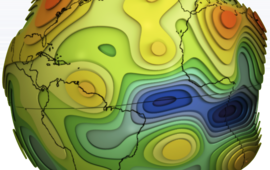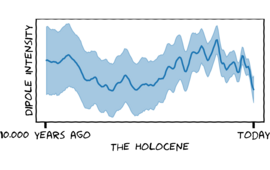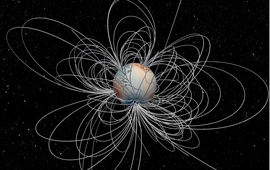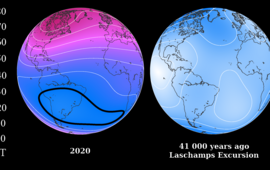GFZ-Modelle des erdmagnetischen Feldes

Datenbasierte Magnetfeldmodelle dienen der Beschreibung des Erdmagnetfelds und seiner Änderung an jedem Ort der Erde und der Untersuchung der zugrunde liegenden Prozesse.
Wir entwickeln globale und regionale Modelle des internen Erdmagnetfelds und tragen in internationalen Kooperation zu weiteren Modellen bei. Dabei handelt es sich um Kernfeldmodelle über aktuelle und lange Zeiträume, die auf Messdaten oder paläomagnetischen Ergebnissen beruhen, sowie um Modelle des Lithosphärenfelds basierend auf Satelliten- und Bodendaten sowie aeromagnetischen Daten.
Beiträge zu Magnetfeldmodellen
Das IGRF ist eine Reihe von mathematischen Modellen des Hauptfeldes der Erde und ihrer jährlichen Veränderungsrate (Säkularvariation).
Die IGRF-Koeffizienten der 12. Generation wurden aus Sätzen von Koeffizienten berechnet, die von den teilnehmenden Mitgliedern der IAGA-Arbeitsgruppe V-MOD erzeugt wurden.
Frühere Modelle und Beiträge zu Modellen
Aus Daten des ersten Jahres der Swarm-Satellitenmission wurde das Swarm InitialField Model (SIFM) hergeleitet. Ein neues Modell des Erdmagnetfeldes und seiner zeitlichen Variation.
GRIMM-3
Die Entwicklung des GFZ Reference Internal Magnetic Model Version 3 ist hauptsächlich eine Weiterentwicklung von GRIMM-2.
Downloads:
GRIMM-3_0.zip, 274 kB, Aug 2011, Fortran95 code for forward modelling for GRIMM-3.0 (development branch) and a single epoch model from GRIMM-3.0, coefficent file.
GRIMM-3_0.mov, 6,4 MB, März 2011, Movie of secular acceleration of the vertical down component of the Earth's core magnetic field.
GRIMM-2 (x)
Diese Seite ist leider nur in englischer Sprache verfügbar.
The GFZ Reference Internal Magnetic Model (GRIMM2) has been derived from nearly eight years of CHAMP satellite data and seven years of observatory hourly means. At high latitudes, full vector satellite data are used at all local times. By doing so, a separation is possible between, on one hand, the fields generated by the ionosphere and field aligned currents, and, on the other hand, the fields generated in the Earth's core and lithosphere. This selection technique leads to a data set where gaps are avoided during the polar summers allowing the modelling of the core field with an unprecedented time resolution. Order six Bsplines are used to model the core field and the mapping of its acceleration is possible from 2001.5 to 2008.5 revealing a rapid and complex evolution over this time period at the Earth's surface. The energy in secular acceleration presents a smooth behaviour in time and is shown to increase continuously from 2003.5 to reach a maximum around 2006.0.. The static core field and its secular variation are all in good agreement with previously published magnetic field models.
Downloads
GRIMM-2.zip, 81 kB, July 2009, Fortran95 code for forward modelling for GRIMM-2 and a single epoch model from GRIMM-2, coefficent file.
GRIMM2x.zip, 89 kB, Oct. 2009, Fortran95 code for forward modelling for GRIMM-2x and a single epoch model from GRIMM-2x, coefficent file.
GRIMM-1
Diese Seite ist zur Zeit leider nur in englischer Sprache verfügbar!
The GFZ Reference Internal Magnetic Model (GRIMM) has been derived from nearly six years of CHAMP satellite data and five years of observatory hourly means. At high latitudes, full vector satellite data are used at all local times. By doing so, a separation is possible between, on one hand, the fields generated by the ionosphere and field aligned currents, and, on the other hand, the fields generated in the Earth's core and lithosphere. This selection technique leads to a data set where gaps are avoided during the polar summers allowing the modelling of the core field with an unprecedented time resolution. Order five B-splines are used to model the core field and the mapping of its acceleration is possible from 2001.5 to 2005.5 revealing a rapid and complex evolution over this time period at the Earth's surface. The energy in secular acceleration presents a smooth behaviour in time and is shown to increase continuously from 2003.5. Due to the regularisation technique introduced, the acceleration energy for spherical harmonics 6 to 11 is significantly larger than for other available geomagnetic models. The static core field, its secular variation and the lithospheric field are all in good agreement with previously published magnetic field models.
Downloads
GRIMM_splines.zip ,36 kB, Juni 2007, GRIMM Gauss-Koeffizienten SH Grade 1 bis 14.
GRIMM_2003.5.zip, 147kB, Aug 2007, GRIMM Gauss-Koeffizienten für das statische Kernfeld, seiner Säkularvariationen und -beschleunigung in 2003.5.
GJI-07-0346-R.pdf 5,1 MB, Feb 2008, GRIMM - The GFZ Reference Internal Magnetic Model based on vector satellite and observatory data (GJI, 2008).
The Digital Magnetic Anomaly Map of the World - WDMAM
The Digital Magnetic Anomaly Map of the World (WDMAM) results from an international effort to build the first global compilation of the wealth of magnetic anomaly information derived from more than 50 years of aeromagnetic surveys over land areas, research vessel magnetometer traverses at sea, and observations from earth-orbiting satellites, supplemented by anomaly values derived from oceanic crustal ages. The objective is to provide an interpretive dimension to surface observations of the Earth's composition and geologic structure. The magnetic anomalies represented on this map originate primarily in igneous and metamorphic rocks, in the Eart's crust and possibly, uppermost mantle. Magnetic anomalies represent an estimate of the short-wavelength (<2600 km) fields associated with these parts of the Earth, after estimates of fields from other sources have been subtracted from the measured field magnitude. The natural increase of temperature with depth in the Earth means that rocks below a certain depth, termed the Curie depth, will be essentially non-magnetic. This depth is typically in excess of 20 km in stable continental regions, and may be as shallow as 2 km in young oceanic regions. Studies of crustal magnetism have contributed to geodynamic models of the lithosphere, geologic mapping, and natural resource exploration. Inferences from crustal magnetic field maps such as these, interpreted in conjunction with other information, can help delineate geologic provinces, locate impact structures, dikes, faults, and other geologic entities which have a magnetic contrast with their surroundings. To this end, the World Digital Magnetic Anomaly Map (WDMAM) is available in both digital and map form at CGMW and GTK.
The GFZ has been involved in the compilation of this map and has built its own version of the map that can be downloaded from GTK. As for the official map, the anomaly field is shown at an altitude of 5 km above the WGS84 ellipsoid. The magnetic fields shown are designed to be internally consistent over the measurement domain, extending from the surface to satellite altitude.
Downloads:
GMJC-Candidate-2.zip, 311MB, Sep 2014, Weltweite ASCII Raster-Datei (GRID) des WDMAM mit einer Auflösung von 0.05 Grad.
model_WDMAM.zip, 6,6MB, Sep 2014, WDMAM Modell Daten (gepackte ASCII-Datei).
WDMAM.jpg, 6,1MB, Sep 2014, Hochaufgelöste Bilddatei der WDMAM (4224x3500 Pixel).
INDEX.jpg, 6,1MB, Sep 2014
GRIMM_L, Version 0.0
We investigated how the noise in satellite magnetic data affects magnetic lithospheric field models derived from these data in the special case where this noise is correlated along satellite orbit tracks. For this we describe the satellite data noise as a perturbation magnetic field scaled independently for each orbit, where the scaling factor has a specified variance. Under this assumption, we have been able to derive a model for errors in lithospheric models generated by the correlated satellite data noise. Unless the perturbation field is known, estimating the noise in the lithospheric field model is a non-linear inverse problem. We therefore proposed an iterative post-processing technique to estimate both the lithospheric field model and its associated noise model. The technique has been successfully applied to derive a lithospheric field model from CHAMP satellite data up to spherical harmonic 120. The model is in agreement with other existing models. The technique can be in principal extended for all kind of potential field data with ”along track” correlated errors.
The reference associated with the model is for now: http://www.solid-earth-discuss.net/4/1345/2012/sed-4-1345-2012.pdf
Downloads:
GRIMM_L120.coeff.zip, 110kB, Nov. 2012, List of Gauss coefficients for the lithospheric field model.
GRIMM_N120.coeff.zip, 193kB, Nov. 2012, Noise model subtracted.
FF-Model


The FF-model is a geomagnetic field model for epoch 2005.4 that has been built from one year of CHAMP and observatory data. In this model, the flow at the top of the liquid outer core is co-estimated together with the field model using the radial diffusion-less induction equation. The constraints are applied exclusively on the flow model. This approach leads to a magnetic field model that is compatible in time with the frozen-flux approximation. In particular, the field model acceleration at spherical harmonic degrees higher than 5 correspond to the acceleration that would be obtained for a static flow. This component of the acceleration is much weaker than the contribution due to the time variation of the flow (see Figure 1). It can be downward continued to the CMB (Figure 2).
Download:
FF-Model.zip, 3.9kB, July 2008, Gauss coefficients for year 2004.5.
Continuous Covariant Constrained-end-points field model - C3FM
This study presents an investigation and description of the secular variation of the Earth's magnetic field between 1980 and 2000. A time-dependent model, C³FM (Continuous Covariant Constrained-end-points Field Model), of the main field and its secular variation between 1980 and 2000 is developed, with Gauss coefficients expanded in time on a basis of cubic B-splines. This model is constrained to fit field models from high quality vector measurements of MAGSAT in 1980 and Ørsted in 2000 and to fit both magnetic observatory and repeat station secular variation estimates for the period in between. These secular variation estimates (first time derivatives) are derived from observatories monthly or annual means and repeat station data in order to reduce the contributions of crustal noise, annual and semi-annual variation. On average, the model input consists secular variation estimates of the X, Y and Z components at 130 locations per month. Treatment of covariance between the different components allows a higher temporal sensitivity of the model, due to the exclusion of some external field variation. The model is computed up to degree and order 15.
The model is a useful extension of the hitherto existing time-dependent description of the secular variation, GUFM which describes the secular variation until 1990. It reveals a short term secular variation on sub-decadal time scale and has a higher spatial resolution, than previously resolved. The model is also valuable to test the frozen flux hypothesis and to link features of the radial field at the core-mantle boundary to the geodynamo.
Downloads:
c3fm_spline.zip, 68kB, Aug. 2007, C3FM Gauss Coefficients SH degrees 1 to 15 (ASCII file containing spline).
c3fm_main_field.zip, 630kB, Aug. 2007, C3FM core field coefficients SH degrees 1 to 15 for each month during 1980 to 2000 (241 ASCII files).
c3fm_sec_variation.zip, 630kB, Aug. 2007, C3FM secular variation coefficients SH degrees 1 to 15 for each month during 1980 to 2000 (241 ASCII files).
c3fm_model_paper_preprint.pdf, 207kB, Aug. 2007, C3FM model paper preprint.
Die CHAOS-Modellreihe beschreibt das Erdmagnetfeld mit hoher räumlicher und zeitlicher Auflösung.
Mehr als 14 Jahre Daten der Satellitenmissionen Oersted, CHAMP und SAC-C, ergänzt mit monatlichen Mittelwertwerten geomagnetischer Observatorien, gehen in dieses Modell ein.
POMME ist ein Hauptfeldmodell, das das geomagnetische Feld von der Erdoberfläche bis zu einer Höhe von einigen tausend Kilometern liefert.












